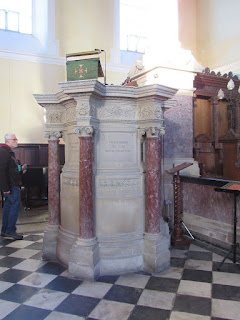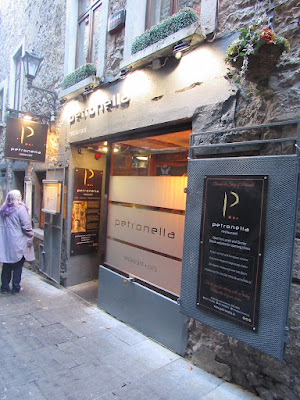We began our journey to Wales today at 5:30 a.m. It would take us two hours to get to the 7:30 ferry boat in the town of Wexford, Ireland--the only ferry running on this day. The hotel provided us with a light snack for breakfast; we would eat a full breakfast on the ferry boat that would cross the St. George's Channel over four hours to land in Fishguard, Wales. The sea didn't look that rough, but the boat rocked enough that you had to ground yourself and acquire a new set of sea legs to keep from falling.
Loading huge buses and trucks as well as cars onto the ferry boat is a slick operation. There are two levels for such vehicles and they just roll onto the ship with ease. Passengers may roam on the top two decks of the ship where there is a dining room, café, cinema, private cabins (only for guides and drivers), playroom for kids, and seats along the sides of the hallways.
Cars line up waiting to board the ferry boat.
Ramps are lowered between the dock and the ship to allow vehicles to roll effortlessly on and off the boat.
I have fond memories of the boat ride thanks to having breakfast with my two new friends from western Pennsylvania. Wayne is a retired minister and Carol is a retired public health nurse. We talked a lot about mainline churches and their struggles to attract parishioners. Many pastors, said Wayne, quit the ministry due to burn-out and a lack of job satisfaction. He made it for 38 years and now subs for pastors who take some time off.
On the road in Wales
Three million people live in Wales where hundreds of coal mines used to produce the slowest-burning coal in the world. (Now, there is only one mine left.) Welsh slate was also mined and together these two resources made Wales very rich. Mining came at a price for the mine workers, however. Children under 12 helped to sort coal. There used to be competitions among the various pits to see who could produce the most coal.
The area west of Cardiff was one characterized by rolling green hills. People used to mine or raise sheep. In the 1950s, 60s, and 70s, the mine workers were highly paid. Unfortunately, the workers suffered from emphysema and most died from it. In the 1980s, the mines closed down because they were running at a loss. It also became cheaper to import coal than to mine it locally. Mining villages were decimated and the people suffered from poverty and drug abuse. The government pumped loads of money into these communities to help them survive.
One of the episodes of "The Crown" features a mining disaster
where 116 schoolchildren and 28 adults were buried alive by coal that
rolled down the hill onto their school on October 21, 1966. Our bus
passed a turn-0ff leading to Aberfan. The photo on the left below shows the
damage done by the coal sliding down the hill. The photo on the right is the
cemetery where the victims are memorialized.

Agriculture
and the film industry have become the substitutes for the mining
industry. Welsh lamb, for example, is the most expensive with the
highest quality of any lamb produced in the world. That is because the
sheep are always walking on the hills, and this makes their meat very lean.
Nevertheless, Welsh farmers are inclined to buy New Zealand lamb for
their tables because it is cheaper than the lamb they produce.
The Welsh topography includes deep valleys and green granite mountains in the north. The mountains actually resemble the Tibetan mountains, which allowed Sir Edmund Hillary to train for his climb to Mt. Everest in 1953.
Wales also has old and dense oak forests and the once-inhabited sites of the ancient Celtic settlers. The Welsh, in fact, are the oldest descendants of the Celtic people and they speak the oldest versions of the Celtic language. It is a poetic language and one where one word can stand for one sentence. Welsh is the first language for many people, and it wasn't until the 20th century that it was written down. So important is the language that people stopped going to church in the 19th century because services were in English. To remedy this situation, the Welsh Methodists went into the coal pits to preach and get the people to sing in Welsh. They also started Sunday schools in Welsh. It worked!
There is a bardic tradition among the Welsh where history and stories have been handed down orally for centuries.
Wales was a patchwork of small ancient kingdoms who were often at war with one another. The bards, however, were allowed to cross borders safely in order to provide news and entertainment to the people. They usually carried a harp to accompany their storytelling in music or a poem. The harp is consequently the ancient symbol of the Celtic people. This tradition of music still prevails in Wales, which has produced many top opera singers.
Wales has more medieval castles than anywhere in Europe because King Edward I of England had them built as a defensive move to control this region. He had defeated the Scots, and he was the first to take Wales.
It is important to note that Wales is not a kingdom but rather a "principality". That means that the oldest son of the king becomes the Prince of Wales as a result of Edward I's defeat of the Welsh in the 12th century. He knew the people would never be ruled by a king, so this was the political compromise.
The flag of Wales is a red dragon on a green and white background. In its battles for the region, the white dragon represented the Anglo-Saxons and the red dragon stood for England. The red dragon won and chased the Anglo-Saxons out.
Minced pie is a Christmas specialty in Wales. It originated with the Crusades where meat was preserved with spices. The same spices are still used today although the pie is not necessarily filled with meat. We tried some minced pie and it was very flavorful.
Wales used to mine gold until the 1950s because it was too difficult and too expensive to mine gold. In the 1990s, however, the price went up so high that they re-opened the mines. Actually, gold mining goes back to the ancient Celts. They created a metal works that allowed them to make ornate pieces that they then sacrificed to the gods. They often threw these pieces into the rivers in Wales and all over Europe where the Celts settled.
The steel plant is now a recycling center.





























































